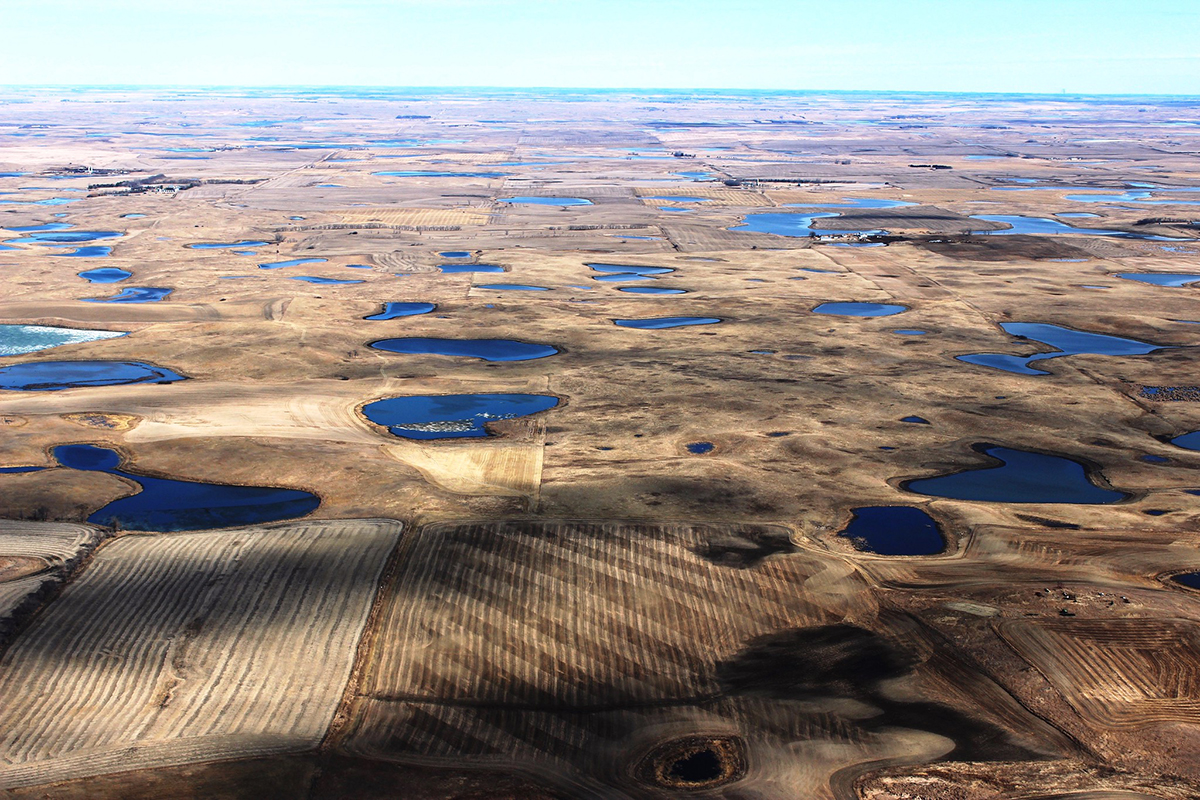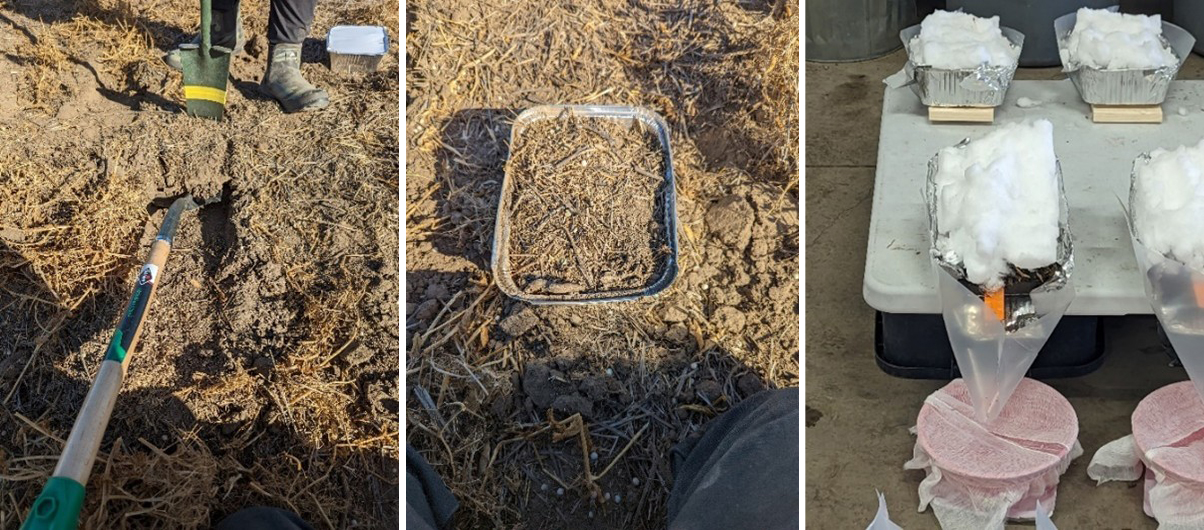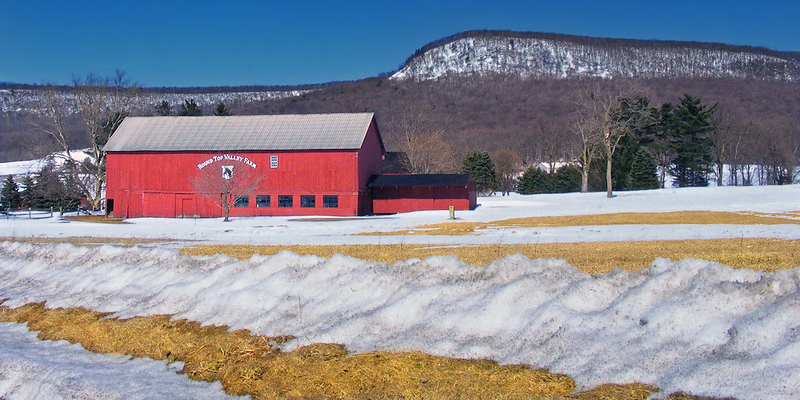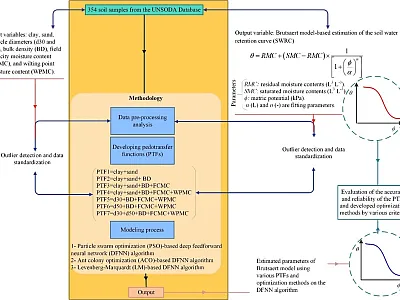Does slope influence soluble phosphorus losses in spring snowmelt runoff in the Prairie Pothole Region of Canada?


Phosphorus (P) losses from agricultural land in the Prairie Pothole Region of Canada are dominated by P dissolved in snowmelt runoff water. This article presents a study showing that slope was not a major driver of P losses in snowmelt runoff. Earn 0.5 CEUs in Soil & Water Management by taking the quiz for the article. This article was prepared as a contribution of the Western Region Nutrient Management Coordinating Committee (WERA-103).
The Prairie Pothole Region extends over approximately 115 million acres from south-central Canada to the north-central United States of America. This region is characterized by hummocky topography where water-shedding knolls and water-accumulating depressions cycle throughout the landscape (Bedard-Haughn & Pennock, 2002). Applied and residual soil P may be lost from the field in runoff water, largely in the dissolved form (Tiessen et al., 2010).
The spring snowmelt runoff represents the major hydrologic event in this region where snow, although making up only 30% of annual precipitation, contributes to more than 80% of annual runoff (Gray & Landine, 1988). In contrast to nutrient losses in rainfall runoff, the movement of snowmelt through crop residues on frozen soils removes and transports mainly soluble rather than particulate forms of P. While much information is available on the influence of slope on runoff from rainfall, the relative importance of slope on nutrient transport in snowmelt is less well understood. Improved understanding of the factors controlling P losses in snowmelt runoff will aid in prediction of losses across landscapes of the northern Great Plains and support management practices intended to promote crop productivity while limiting off-site losses. Thus, research was conducted to assess the impact of slope and landscape position (landform complex) on influencing soluble P losses in snowmelt runoff.
Materials and methods
Experimental design
Phosphorus transport in runoff was assessed in a snowmelt runoff simulation using intact soil slabs having dimensions of 8.5 × 6 × 2.5 inches (Figure 1) collected from two field experiments established at sites from the Prairie Pothole Region in southern Saskatchewan, Canada. These soil slabs are collected intact to maintain the surface residue, soil structure, and profile characteristics as they exist in the field after harvest and then frozen to simulate winter conditions as described in Wiens et al. (2019). Experiment 1 investigated landform complex areas (0–3%) slope, and Experiment 2 expanded these to a much greater slope gradient (0–30%).

In Experiment 1, the fertilizer and cropping management practice treatments included variable-rate N and P fertilizer application, post-harvest prescriptive shallow tillage, and annual forage polycropping. They were applied to hydrologically isolated, drained basins with each treatment selected for its potential ability to mitigate P losses in snowmelt runoff. Soil slabs were collected from replicated landform complex positions within each drained basin, including upslope, midslope, and depression, following crop harvest over three years (2021–2023).
Experiment 2 was conducted to directly assess the influence of slope on soluble P losses in simulated snowmelt runoff from soil slabs collected from a field experiment situated on an upslope landscape position where monoammonium phosphate was applied at a constant rate of 36 lb P2O5/ac to the plot areas. Soil slabs from both field sites were subjected to a simulated snowmelt runoff experiment, which is described below.
Simulated snowmelt runoff experiment
In Experiment 1, each frozen soil slab was set at a predetermined angle to represent the average slope from where it was removed from the field with slopes ranging from 0 to 3%. In Experiment 2, soil slabs were each set at slope percentage treatments of 0.0, 7.5, 15.0, 22.5, and 30.0% to assess a broader range of slope conditions than used in Experiment 1 (Figure 1). Snow was then added to a depth of 7.5 cm on a per-area basis (1.3 cm snow water equivalent) to each slab and was allowed to melt at a constant temperature of 50℉ in a controlled environment room to approximate the daytime high temperature during peak spring snowmelt. Runoff water samples were collected over the melt and analyzed for soluble reactive inorganic P (SRPi). Particulate P was measured in selected samples and found to be negligible, consistent with previous studies of snowmelt water composition in the region (Cade-Menun et al., 2013). Total runoff water volume was also measured and used to calculate P load.
Results
For each year that the snowmelt simulation was conducted with soil slabs collected from Experiment 1, soluble P concentration was not significantly influenced by landform complex and associated slopes (Table 1). Similarly, manipulation of slope gradient over the range of 0 to 30% did not have a significant influence on SRPi concentration or P load in the snowmelt simulation conducted on slabs collected from Experiment 2 (Table 2).
Landform complexa and associated average slope percentage (n=16) | Snowmelt simulation SRPib | ||
|---|---|---|---|
2021 | 2022 | 2023 | |
ppm PO43––P | |||
Upslope (1.1%) | 2.39 ± 2.3 | 1.35 ± 1.7 | 1.77 ± 1.6 |
Midslope (1.7%) | 2.72 ± 2.3 | 0.89 ± 0.7 | 1.06 ± 0.1 |
Depression (1.3%) | 2.17 ± 2.7 | 1.08 ± 0.9 | 1.20 ± 1.3 |
Pr>F | 0.74 | 0.40 | 0.25 |
aA transect of sampling points was established across each basin with samples collected at three replicated landform complex (i.e., complex) positions, including upslope, midslope, and depression. | |||
bSoluble reactive inorganic P (King et al., 2017). | |||
Factor | Treatment | SRPia | P load |
|---|---|---|---|
% Slope | ppm PO43––P | g P/ac | |
Slope (n=4) | 0 | 0.71 ± 0.36 | 22 ± 15 |
7.5 | 0.67 ± 0.29 | 20 ± 5 | |
15 | 0.56 ± 0.31 | 16 ± 12 | |
22.5 | 0.73 ± 0.38 | 24 ± 17 | |
30 | 0.77 ± 0.36 | 23 ± 11 | |
Pr>F | 0.84 | 0.71 | |
aSoluble reactive inorganic P (King et al., 2017). | |||
Discussion
In the snowmelt simulations conducted in Experiment 1 over three years, soils from different landscape positions with varying slopes did not significantly influence soluble reactive P concentrations in snowmelt across the relatively gentle slope range (0–3%) encountered in the field experiment. Even across a much wider slope percentage range as assessed in soils from Experiment 2, varying the slope did not significantly impact soluble P concentration or P load in snowmelt runoff from the intact soil slabs. These results reveal the lower degree of impact that landscape element and slope have on potential P export in snowmelt runoff in variable topographies of the Prairie Pothole Region compared with much greater influence of slope on rainfall runoff dominating in more temperate regions as shown by Zhang et al., (2019).

Snowmelt runoff is less erosive than rainfall as it generally occurs at a slower rate and with less intensity than rainfall runoff (Ginting et al., 1998; Owens et al., 2011). Further, the frozen soil condition prevents soil particle detachment, favoring the transport of nutrients in the dissolved rather than particulate form (Panuska et al., 2008). The unique conditions of the Prairie Pothole Region, where annual runoff is dominated by snowmelt water flowing across frozen soils with gently sloping topography, are the likely cause of the muted influence of landscape position and slope on driving P losses from agricultural landscapes compared with those in which rainfall runoff dominates.
Conclusion
Unlike P losses associated with rainfall runoff, this study found that slope had a muted impact on potential P losses in snowmelt runoff from P-fertilized soils in the Prairie Pothole Region. Risk indicators and models developed to predict P export in this region may reflect this, and efforts to reduce soluble P concentration in snowmelt runoff should focus on management practices to avoid P loading and that promote crop utilization of applied and residual soil P.
References
Bedard-Haughn, A. K., & Pennock, D. J. (2002). Terrain controls on depressional soil distribution in a hummocky morainal landscape. Geoderma, 110, 169–190. https://doi.org/10.1016/S0016-7061(02)002229-X
Cade-Menun, B. J., Bell, G., Baker-Ismail, S., Fouli, Y., Hodder, K., McMartin, D. W., Perez- Valdivia, C., & Wu, K. (2013). Nutrient loss from Saskatchewan cropland and pasture in spring snowmelt runoff. Canadian Journal of Soil Science, 93, 445–458. https://doi.org/10.4141/CJSS2012-042.
Ginting, D., Moncrief, J. F., Gupta, S. C., & Evans, S. D. (1998). Interaction between manure and tillage system on phosphorus uptake and runoff losses. Journal of Environmental Quality, 27, 1403–1410. https://doi.org/10.2134/jeq1998.00472425002700060017x
Gray, D. M., & Landine, P. G. (1988). An energy-budget snowmelt model for the Canadian Prairies. Canadian Journal of Earth Sciences, 25, 1292–1303.
King, T., Schoenau, J., & Elliott, J. (2017). Relationship between manure management application practices and phosphorus and nitrogen export in snowmelt run-off water from a black chernozem in Saskatchewan soil. Sustainable Agriculture Research, 6, 93–114. https://doi.org/10.5539/sar.v6n2p93
Owens, L. B., Bonta, J. V., Shipitalo, M. J. & Rogers, S. (2011). Effects of winter manure application in Ohio on the quality of surface runoff. Journal of Environmental Quality, 40, 153–165. https://doi.org/10.2134/jeq2010.0216
Panuska, J. C., Karthikeyan, K. G., & Norman, J. M. (2008). Sediment and phosphorus losses in snowmelt and rainfall runoff from three corn management systems. Transactions of the ASABE, 51, 95–105. https://doi.org/10.13031/2013.24230
Tiessen, K. H. D., Elliott, J. A., Yarotski, J., Lobb, D. A., Flaten, D. N., & Glozier, N. E. (2010). Conventional and conservation tillage: Influence on seasonal runoff, sediment, and nutrient losses in the Canadian Prairies. Journal of Environmental Quality, 39, 964–980. https://doi.org/10.2134/jeq2009.0219
Wiens, J. T., Cade-Menun, B. J., Weiseth, B., & Schoenau, J. J. (2019). Potential phosphorus export in snowmelt as influenced by fertilizer placement method in the Canadian Prairies. Journal of Environmental Quality, 48, 586–593. https://doi.org/10.2134/jeq2018.07.0276.
Zhang, R., Li., M., Yuan, Xi., & Pan, Z. (2019). Influence of rainfall intensity and slope on suspended solids and phosphorus losses in runoff. Environmental Science and Pollution Research, 26, 33963–33975. https://doi.org/10.1007/s11356-018-2999-6
Self-study CEU quiz
Earn 0.5 CEUs in Soil & Water Management by taking the quiz for the article. For your convenience, the quiz is printed below. The CEU can be purchased individually, or you can access as part of your Online Classroom Subscription.
Phosphorus loss in snowmelt runoff in the Prairie Pothole Region predominantly exists in which form?
a. Particulate P.
b. Organic P.
c. Soluble P.
d. Equally distributed between particulate and soluble P.
The influence of slope on driving P losses in snowmelt runoff was tested across a narrow (0-3%) and wide (0-30%) slope range in this work. Across what range was slope found to be a significant factor?
a. Narrow.
b. Wide.
c. Both.
d. Neither.
Which of the following was NOT attributed to the muted influence of slope in driving P losses in snowmelt compared with rainfall runoff?
a. Greater infiltration during snowmelt compared to rainfall.
b. Snowmelt runoff occurring slower than rainfall runoff and with less energy.
c. Soil particle detachment being prevented by frozen soil.
d. Snowmelt runoff being less erosive than rainfall.
In Experiment 2, while slope did not impact soluble P concentration in snowmelt runoff, the impact on P load was statistically significant.
a. True
b. False.
Which of the following does NOT describe the unique hydrological conditions of the Prairie Pothole Region?
a. Hummocky topography.
b. Poor water infiltration limited by soil texture.
c. Annual runoff dominated by snowmelt.
d. Snowmelt runoff generally occurring across frozen soils.
Text © . The authors. CC BY-NC-ND 4.0. Except where otherwise noted, images are subject to copyright. Any reuse without express permission from the copyright owner is prohibited.








